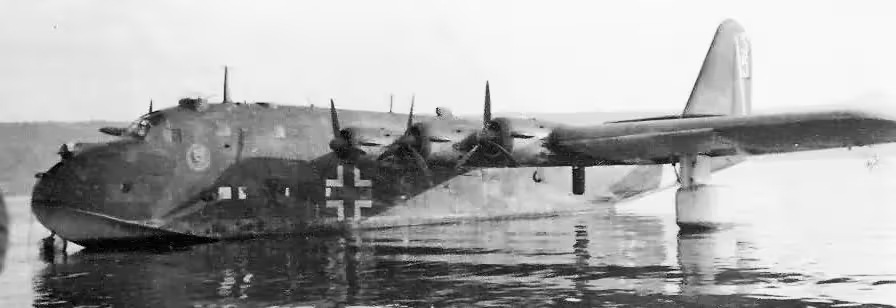Warplanes of Germany: Luftwaffe Blohm + Voss BV 222 Wiking
Blohm + Voss BV 222 Wiking

(Luftwaffe Photo)
Blohm + Voss Bv 222 Wiking.
The Blohm & Voss BV 222 Wiking (pronounced "Veeking") was a large six-engined German flying boat designed and built by the German aircraft manufacturer Blohm & Voss. It was the largest flying boat to attain operational status during the Second World War. The BV 222 was originally developed during the late 1930s as a commercial venture to serve the transatlantic and other long distance routes of the German flag carrier Luft Hansa. It featured a relatively uninterrupted interior, free of bulkheads, and retractable floats; its use of diesel-powered engines made it easier to be refuelled at sea. By the time of its maiden flight on 7 September 1940, Nazi Germany was almost one year into the Second World War and the operation of long distance civil services was not realistic, thus development was reorientated towards military roles.
On 10 July 1941, V1 undertook its first cargo transport mission with the Luftwaffe; further logistics use proceeded thereafter. Later that year, the first armed BV 222s were delivered. Production standard aircraft, designated BV 222C, did not emerge until 1943.The BV 222 was operated by the Luftwaffe, typically for logistical purposes, across numerous theatres, including the Norway, France, North Africa and even the Arctic. At one point, Nazi officials were considering establishing a long distance air route between Germany and Japan using modified BV 222s flying from Kirkenes in north Norway to Tokyo via Sakhalin Island, a distance of 6,400 km (4,000 mi). After the Allied Invasion of Normandy in June 1944, all of the remaining BV 222s were transferred to KG 200. At the end of the conflict, several BV 222s were captured and subsequently operated by both the United States and Britain; they were studied and influenced the design of future flying boats. No BV 222s have been preserved. (Wikipedia)

(Luftwaffe Photo)
Blohm + Voss Bv 222 Wiking in flight.

(Luftwaffe Photo)
Blohm + Voss Bv 222 Wiking.
Three Blohm + Voss BV 222 Wikings were captured and subsequently operated by Allied forces: C-011, C-012, and C-013. C-012, captured at Sørreisa in Norway after the war along with V2, was flown by Captain (N) Eric Brown from Norway to the RAF station at Calshot in 1946, with RAF serial number VP501. After testing at Marine Aircraft Experimental Establishment at Felixstowe it was assigned to No. 201 Squadron RAF, who operated it up to 1947, when it was scrapped.

(Bundesarchiv, Bild 146-1978-061-09 / CC-BY-SA 3.0)
Blohm + Voss BV 222 Wiking.




(Luftwaffe Photos)
Blohm + Voss BV 222 Wiking.


(USN Photos)
Blohm + Voss BV 222 seaplane at Trondheim, Norway, undergoing tests by the U.S. Navy, ca 1945-46. This aircraft is one of two flown by the USN, designated USA C-011 and C-113.
BV 222, USA C-011 and C-013 were captured by US forces at the end of the Second World War. On 15 August and again on 20 August 1945, LCdr Richard Schreder of the US Navy performed test flights along with the Luftwaffe crew of one of the Bv 222 Wiking aircraft that had been acquired by the US. In two flights resulting in a total flight time of 38 minutes they experienced 4 engine fires. While many spare engines were available they were of substandard quality due to the lack of quality alloys near the end of the war, and caught fire easily. Since the aircraft was unairworthy with these engines, the aircraft was supposedly taken out to open water and sunk by a Navy Destroyer.
Other reports indicate the US captured aircraft were flown or shipped to the US. Convair acquired one for evaluation at the Naval Air Station Patuxent River, the intensive studies leading to the hull design of their Model 117 which in turn led to the R3Y Tradewind. Their subsequent fate is unknown. The V2 aircraft briefly wore US markings in 1946. Strangely the V2 aircraft had identification markings given to her from the original V5 aircraft for Operation Schatzgräber.
V2 was later scuttled by the British who filled her with Bv 222 Wiking spare parts from the base at Ilsvika to weigh her down. V2 was towed to a position between Fagervika and Monk’s island where it is thought she now rests perfectly preserved on the seabed, owing to low oxygen levels in the water. There are plans to raise and restore this aircraft.





